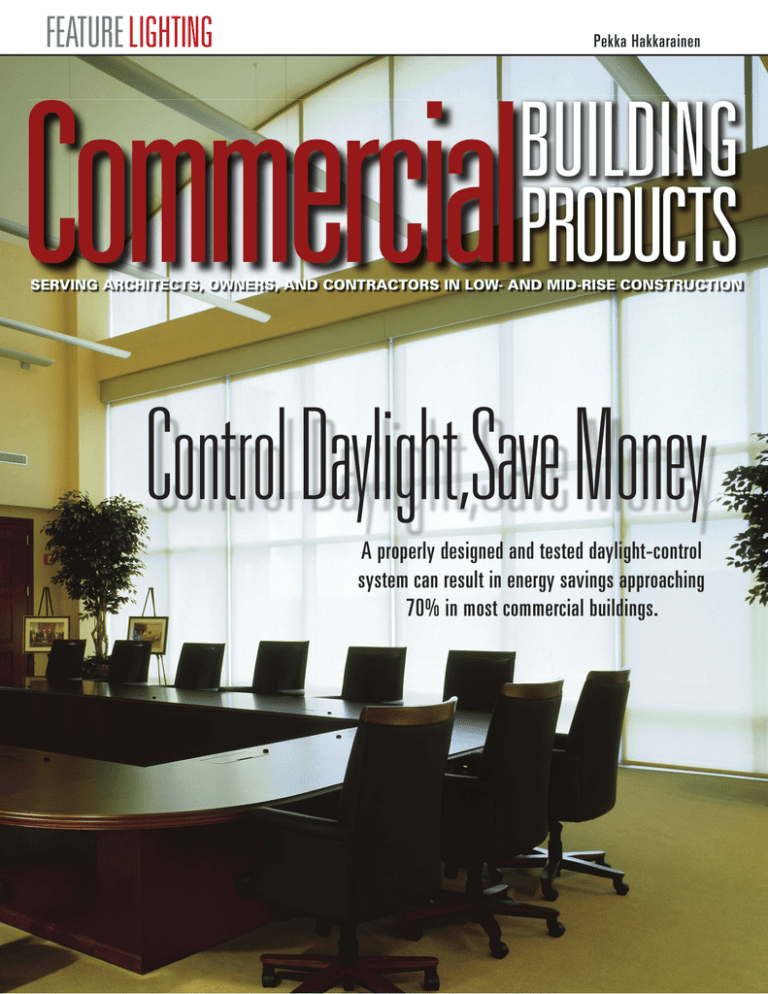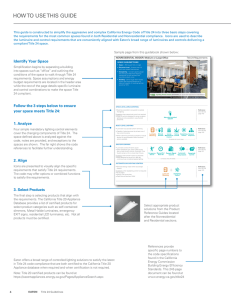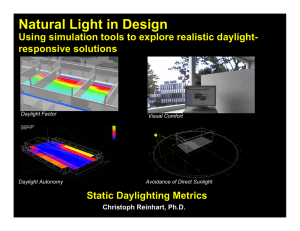
FEATURE LIGHTING
Pekka Hakkarainen
Commercial
BUILDING
PRODUCTS
SERVING ARCHITECTS, OWNERS, AND CONTRACTORS IN LOW- AND MID-RISE CONSTRUCTION
Control Daylight,Save Money
A properly designed and tested daylight-control
system can result in energy savings approaching
70% in most commercial buildings.
FEATURE LIGHTING
C
ommercial buildings are forced
to face the high cost of energy
every day. It’s the nature of operating a business. Despite the fact that
most lighting fixtures in schools, offices,
and retail stores use energy- efficient
fluorescent lamps, lighting remains the
single largest source of energy consumption for these buildings, accounting for
35% to 65% of overall energy use.
The good news is that there are
several ways to reduce and manage the
amount of energy used by a facility, as
well as the associated operating costs.
One of the most effective strategies for
achieving energy efficiency is to include
a daylighting-control system into a
building’s plans.
Despite the high cost of energy,
electric light typically is wasted by being
operated at 100% of capacity all day,
even when there is available sunlight to
offset the need for full output. This is an
extremely uneconomical practice, especially during peak hours when electricity
and corresponding demand charges are
high. Daylighting design takes advantage of the available sunlight, making
it possible to reduce electric light levels
and save energy.
Daylighting was once considered
merely a method for bringing more
sunlight into a building using architec-
tural features such as light shelves, large
window-to-wall ratios, and skylights.
Now, however, daylighting is more
accurately described as a comprehensive design technique in which the goal
is to create an efficient lighting system
around the concept of incorporating
as much daylight as possible, thereby
reducing or supplementing the need
for electric light. Effective daylighting
systems today integrate with lighting
control and controllable window
systems to bring light into a building
and to effectively manage that light.
Saving energy
Sustainable design is no longer an
option for many commercial projects—
especially as green building codes and
guidelines become more prevalent. The
federal energy bill, passed by Congress
and signed by President Bush on August
8, 2005, supports sustainable design by
offering tax deductions for constructing
energy-efficient commercial buildings.
The legislation provides a tax deduction of as much as $1.80/sq. ft. for new
or renovated buildings that exceed the
ASHRAE 90.1-2001 standard by 50%,
with additional deductions for lighting,
HVAC systems, and the building envelope. Lighting improvements alone can
save building owners $0.60/sq. ft.
California actually mandates the
use of skylights and daylighting-control
systems in single-story commercial
buildings with a ceiling height greater
than 15 ft. in the 2005 edition of Title
24, the state’s energy code.
Retail buildings that incorporate
high-performance designs and energyefficient lighting systems can actually
reduce energy consumption by 50%,
when compared with conventional
building designs, according to the U.S.
Dept. of Energy. By effectively managing
both sunlight and electric light, typically
by integrating daylighting design with a
quality lighting-control system, such as
fluorescent lighting control with digital
dimmable ballasts, facilities can save
as much as 70% of current energy use.
Productivity and sales
Beyond saving energy by taking advantage of available sunlight, facilities can
actually improve productivity, satisfaction, and sales while improving the
overall health and morale of the building’s occupants.
Dozens of studies have confirmed
that classrooms are more effective
learning environments with greater
amounts of daylight. Likewise, office
environments and employee productivity have been shown to directly
improve with the proper balance of
daylight and electric light in the workplace. Some studies show that bringing
more daylight into retail stores has a
positive effect on sales.
The cost of an employee
(including salary, benefits, and overhead) far exceeds the energy cost in
any building. That is why ergonomic
lighting—lighting that is designed and
installed in a way that considers the
physical and psychological needs of
the occupants—pays big dividends for
companies today.
Integration
Due to its remarkable evolution over
the past five years or so, daylighting
design has garnered much attention in
the commercial-building arena. Effective daylighting systems today provide
a comprehensive and integrated system
for balancing building-wide efficiency
by regulating an appropriate balance
between natural and artificial light
levels within the interior of a building.
Integrated
daylighting-control
systems consist of controllable lighting
fixtures (such as dimmable fluorescent
systems), motorized window covers,
photosensors that measure light levels,
and a lighting controller that adjusts electric light levels and the position of window
Integrated systems
consist of controllable
fixtures, motorized
window covers,
photosensors, and a
lighting controller to
adjust the components
and maintain the
prescribed light level.
covers to maintain the prescribed light
level throughout the day.
A key element to system success
is managing the proportionate levels of
electric light output through a lightingcontrol system. To realize the full
benefits of daylighting design, a quality
lighting-control system must maintain
proper illuminance levels by accurately
adjusting the amount of electric light
output in response to the amount of
daylight measured by photosensors.
Not all lighting-control systems
provide daylighting functionality, so
it is important to research this in the
initial design phases to avoid a costly
mistake. Recent developments in fluorescent lighting control include digital
addressable ballasts, a technology that
facilitates daylighting and can provide
easy installation and maintenance.
In fact, many commercial, retail,
and education facility projects now are
using fluorescent-based, lighting-control
systems with dimmable digital ballasts
that incorporate daylighting as part of
the control system. Daylighting control
zones are very often different from occupant control zones, and several zones
with different light output requirements
may be controlled using the signal from a
single sensor. The result is superior performance and a high level of flexibility.
The immediate effect of bringing
more daylight into a building is that
window shading in some form or other
is required to regulate heat and glare.
Controllable window treatments provide
a good solution to this, and also help
to reduce the cooling load and protect
interior surfaces from fading caused by
UV and near-UV wavelengths. Controllable window coverings integrate with
the overall system and are adjusted by
a photosensor, typically placed on the
ceiling one window height into the
room from the window.
It is important to protect occupants from radiant heat and glare, which
becomes uncomfortable and can reverse
the productivity-enhancing effects of
natural light. Integrating controllable
shades with the daylighting system helps
maximize the efficiency, functionality,
and comfort of the interior environment.
Another popular design technique
is to integrate with a building-management system, providing a single point of
control for all of the major building functions (HVAC, lighting, fire, and safety). As
building-wide integration systems evolve,
they are providing owners and managers
with better energy control throughout
a building. As part of this integration,
daylighting design provides better lighting
and the opportunity for even greater
energy efficiency, than can be achieved
with more conventional methods.
Designing for daylighting
Effective daylighting system integration
depends on the architectural features of
a building, the interior design, exterior
obstructions, and weather conditions. It
is advisable to consider building exposures in the initial planning phase. The
northern exposure frequently provides
the best daylight source because all of
the light is diffuse and relatively free
from glare. The southern exposure, on
the other hand, may need overhead
shielding from high midday sun angles.
East and west windows present a greater
risk for direct sun glare. However, the
glare usually can be effectively managed
with motorized window coverings.
Daylighting needs to be adapted
to the individual building features to
achieve optimal performance. In addition, when designing a system, the
sensor location is somewhat critical
because it needs to accurately represent
the incidental daylight that corresponds
with the space. Typically, the sensor
is located on the ceiling. In a working
environment, this is usually above a
desk. Photosensors should never look
directly toward the building exterior
because glare and direct sunlight can
generate a false measurement.
FEATURE LIGHTING
Controllable window treatments regulate heat and glare and protect interior surfaces from fading.
35% lighting
27% space cooling
16% space heating
7% refrigeration
5% other
4% office equipment
3% water heating
3% cooking
In a typical commercial building, lighting consumes the greatest amount of energy, ranging from 35% to 65%.
When assembling a system, it is a
good idea to test the design, either with
a physical model or digital simulation. A
lighting designer can also provide good
insight and work with the architectural
team to create an optimal arrangement
and help reduce the chances of costly
errors and omissions.
After implementing a daylighting
system, commissioning is necessary to
ensure that it functions properly. Once
a complicated process, commissioning
a system has been simplified in recent
years. Manufacturers now offer trained
technicians who know how to efficiently
perform this job.
With the proper planning, a
daylighting system can be very economical.
In some cases, initial costs will be higher
than with conventional lighting systems
but, by reducing the electric light output,
and heating and cooling loads, the facility
will realize lower long-term energy costs.
Automatic systems that switch off or
dim the lights in response to daylight are
highly effective in office, classroom, institutional, and retail environments. With
the addition of controllable window coverings, energy savings could reach 70%.
Daylighting design is not just for
new-construction projects. It can also
effectively be retrofitted for existing buildings. In fact, most U.S. commercial
buildings are candidates for daylighting
integration. As more building owners
demand high-performance designs that
promote productivity and energy-efficiency and meet various green building
codes and guidelines, knowing the latest in
daylighting and advanced lighting controls
allows designers and contractors to provide
an environmentally friendly, cost-effective,
and high-performance facility.
Pekka Hakkarainen is vice president at Lutron
Electronics Co. Inc., Coopersburg, PA. He
currently serves as vice president, technical
and research, for the Illuminating Engineering
Society of North America (IESNA). He is
past-chair of the National Electrical Manufacturers Association (NEMA) Lighting Controls
Council, outgoing chair of the IESNA Papers
Committee, and past chair of the IESNA Light
Sources Committee.
Reprinted with permission from Commercial Building Products, May 2006.
®COMMERCIAL BUILDING PRODUCTS. All Rights Reserved. On the Web at www.cbpmagazine.com
May 2006 P/N 367-1265




